Action Comics #1 (1938)
by Fred Guardineer
While Superman gets all the glory, he wasn’t the only DC superhero to debut in Action Comics #1.
We also get Zatara by Fred Guardineer (who sometimes uses the pen name “Gene Baxter” and who has other stories in this issue).
Guardineer is not among the most known Golden Age creators; he died in 2002.

In classic Golden Age style, the story doesn’t bother with an origin. Zatara is introduced as a magician who fights crime with a sidekick name Tong.

Getting this out of the way: Zatara is a rather blatant copy of Mandrake the magician, created in 1934. While Zatara doesn’t have his trademark moustache in his very first issue, the two are virtually indistinguishable. Can you tell at first glance if this is Mandrake or Zatara?

(it was Mandrake)
You might want to give Zatara the benefit of the doubt… after all Mandrake’s look is fairly generic… except Mandrake ALSO has a muscular sidekick with Lothar.
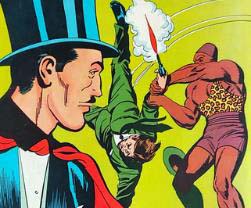
I haven’t read much Mandrake, but from what I can tell Lothar is generally written better than other black characters of the same era. Which is not saying much, admittedly.
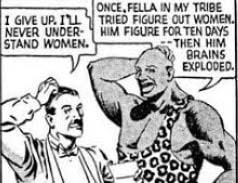
But back to Zatara. His magic crystal ball tells him that the villainous Tigress is going to rob a train, so he intervenes with the police.
Kind of weird from a modern perspective to see a magician get involved with street crime, but that’s fairly common for the times.

Kind of a dick move to use one of the policemen as a human shield, though.

Good thing that, as a magician, Zatara can do pretty much whatever the plot needs.

Now, I mentioned Tigress. If you’re expecting to see a feline-themed supervillain… prepare to be disappointed, because Tigress is just a woman wearing a striped shirt.
That’s it.

Superman can’t fly yet in Action Comics #1, and Zatara is barely able to float.

Zatara’s “detective friend” Brady is found dead and is accused of being “crooked” because… I’m a bit lost on this. Are they thinking he was connected to Tigress and warned her of Zatara’s involvement?
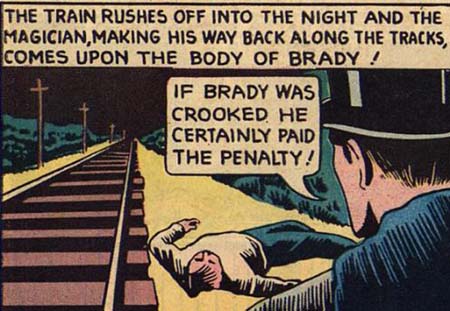
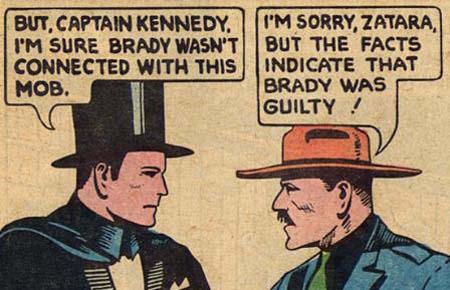
The clues to this mystery are a chalk mark left on the train car, and the train inspector named Babcock. Who I can totally believe chose villainy as revenge against being named Babcock.


Zatara then decides to prepare a trap for Tigress before she can rob the next train, which will transport precious jewelry.
And this is where Zatara reveals his main gimmick: his “spells” are just ordinary words spelled backwards.

And Zatara’s first backwards spell IMMEDIATELY fails!!!
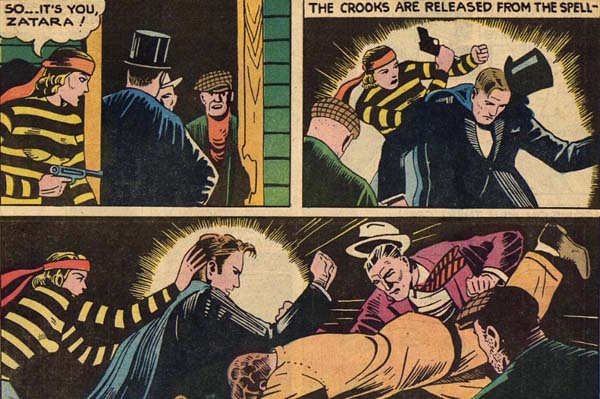
Great job, Zatara. How the heck did you manage to stick around for so long!?

Honestly I’m kind of rooting for Tigress now.

Why didn’t you remove the knots earlier? And why didn’t you even try using a spell, they didn’t even gag you!!!
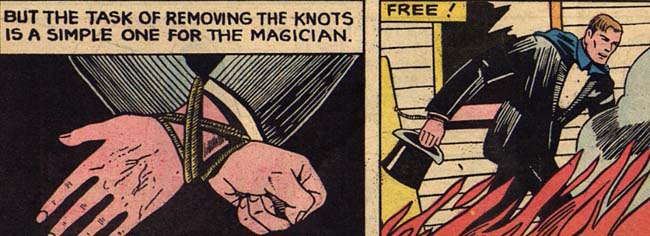
I mean he can teleport Tong to help him whenever he wants!

Just saying, you could’ve ordered Tigress to surrender or something, instead of waiting for Babcock to show up and hypnotize him.

If Zatara fires a gun, should it have a “gnab” sound effect?

Zatara then hops on a different train with the same mark of the first one.
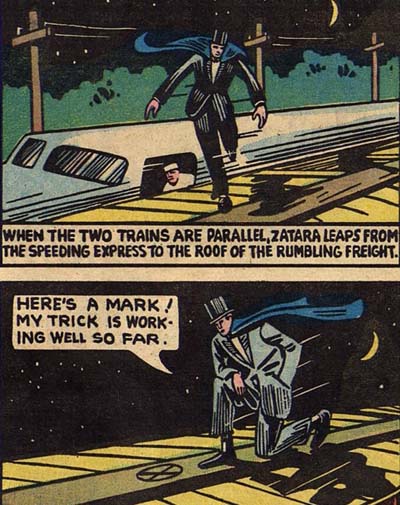
The mark is, of course, the signal the criminals use to spot which car train they need to steal from.

Did you think Zatara grabbed that gun just to disarm the guy? NOPE!

How is Tigress constantly sneaking up on you, Zatara? Even on a train when she’s wearing a long skirt!!!
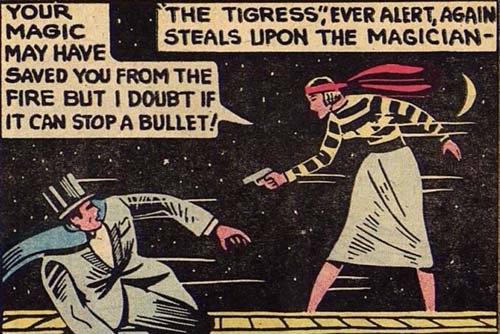
Uhm, normally I would say this was caused by a miscommunication between the writer and the artist, but in this case they’re the same person. HOW IS THAT A BULLET AND NOT A BANANA!?!?

And how the heck does she manage to get away!?!?

And so we end with the mark being fully explained, exonerating Brady…
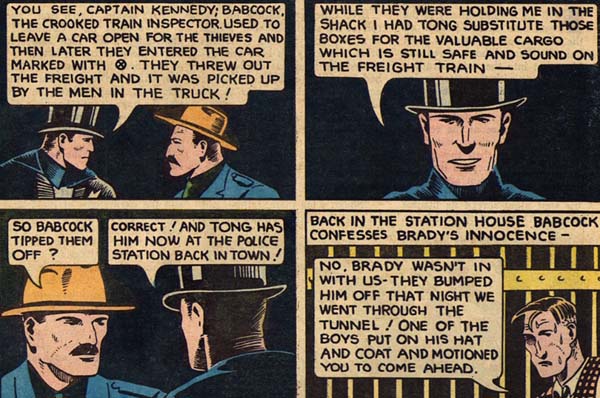
…and Zatara vows to capture Tigress another day.

Based on his performance here, I don’t like his chances.
For completion: in addition to Superman and a bunch of one-page humor comics, here’s the rest of the protagonists of Action Comics #1.

Lacirotsih ecnacifingis: 01\3
Zatara is ONLY remembered for being Zatanna’s father, and none of his adventures are.
Revlis Ega-ssen: 01\7
We have a magician that is either all-powerful or completely useless depending on the panel, and apparently a bulled the size and shape of a banana.
Seod ti dnats eht tset fo emit? 01\0
Reading other stories from the very very early Golden Age helps understanding just how groundbreaking Superman was, because this hasn’t aged well.
The basic plot is fine, but Zatara is utterly inconsistent in everything. It is kind of interesting to see a female crime boss this far back, but that’s about it.
Woh esolc si siht ot eht nredom retcarahc? ![]() \
\![]()
It’s hard to identify a “modern character” for Zatara. He didn’t even get his first name Giovanni until well after the Golden Age!
Zatara was a big enough deal to snatch a few covers from Superman, and lurked around in the 40s and late 50s. He didn’t really get to be a big name; I blame the fact that he didn’t join the Justice Society. Possibly because, let’s face it, Doctor Fate is far more interesting than Zatara ever was!
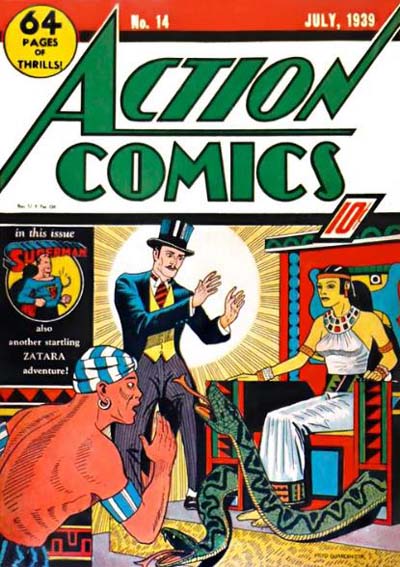
The closest thing to a call to fame came in 1964 thanks to his daughter Zatanna, who started a storyline looking for Zatara that was one of the VERY few DC crossovers between multiple series of the era.
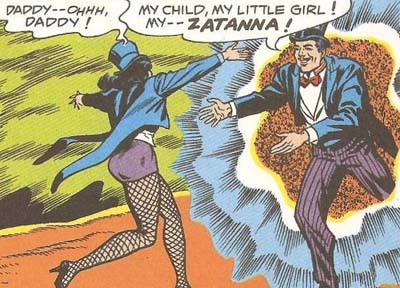
Considering “Zatara” is his last name, he literally lives through her daughter since her full name is actually Zatanna Zatara.
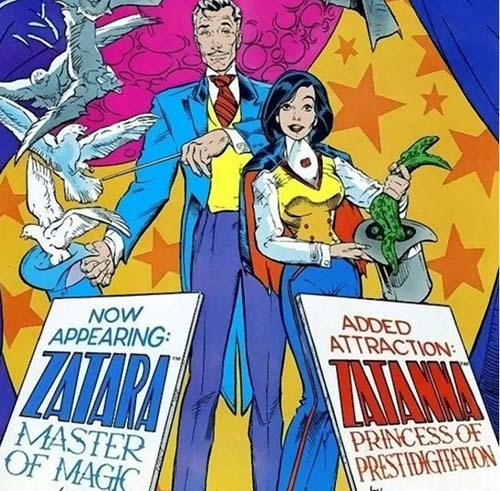
It’ll take a long time before I get to cover Zatanna’s debut. I don’t have to think too much about why she managed to stick around better than her father.

He’s died a bunch of times, but he pops up as a ghost to help his daughter.
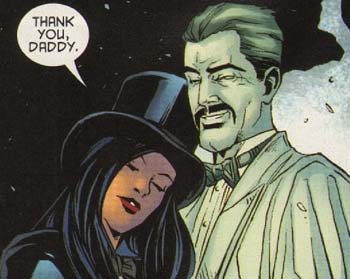
I’m guessing the only reason Zatara kept any sort of relevance, and why he was chosen as the father of a new heroine, is because he debuted in Action Comics #1.
I seriously doubt anyone is going to do something with him that doesn’t involve his daughter, but it’s not like he’s a bad character in his own right.


The story may not be much, but I love the art! It’s clean, expressive, and moody. Even when two characters are talking, such as Zatara and Captain Kennedy, Guardineer uses just a few lines to communicate subtle emotions and interpersonal dynamics. The panel where Zatara finds Brady’s body also stands out. The composition leads the eye around the train track and Zatara and finally points to Brady, making the image startling. This type of composition ability seems lost in a lot of modern comics.
He not only showed up as a ghost to help his daughter, but also to help his former girlfriend Charity in the pages of James Robinson’s Starman book.
As for the bullet-banana thing, while the writer and artist were one and the same, maybe the letterer wasn’t? I don’t know how lettering worked in the Golden Age, but certainly a distinct letterer has been credited since the mid-60’s. I suppose the real question is, was there an editor/proofreader for the book at all?
Zatara also factored into the Neil Gaiman “Books of Magic” series, where the Phantom Stranger shows Timothy Hunter the price Kent Nelson paid for being Doctor Fate, Zatara speaks to Timothy poignantly about how he had not just spoken spells backwards, he had also lived his life backwards (hiding his magic as stage illusion, putting his career before his family, putting his trust in someone who betrayed him), and Sargon the Sorcerer warns him about giving his life to magic without making sure to keep part of it for himself. He also factors into John Constantine’s story, as while Constantine has an on/off relationship with Zatara, she doesn’t know Constantine is the one who betrayed Zatara’s trust and cost him his life.
My impression was that since Brady was ahead of the rest of them, on the car being robbed, and since the robbers were ready to shoot the police atop the train as if they were tipped off, that’s why the officer who was shot figured Brady might be shady and when his body was thrown from the train figured he betrayed his fellow thieves or something. But it does come very suddenly, like everything else in that story.
Coincidentally, I just embarked on a reread of Alan Moore’s Swamp Thing, which features Zatara’s death–one of them, anyway.
For 1938, the treatment of Tong is pretty darn good. He speaks formal, articulate English and does not suffer from the ugly caricatures often used for non-caucasians of the period.
If only he didn’t call Zatara “Master.” I suppose it could be seen as an honorific – he is “Zatara, Master Magician” after all – but it’s still a bit on the nose.